The Prizewinner 1996
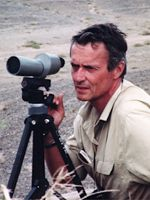
| Name | George Beals Schaller |
|---|---|
| Born on | 26 May 1933 |
| Nationality | United States of America |
| Title | Director for Science, The Wildlife Conservation Society |
Reason for Awarding
Dr. George Beals Schaller has been engaged in continuous research on wild animals, based on field surveys, from his university days to the present covering many regions of the world, including North and South America, Asia and Africa, and has targeted a large variety of wild animal species.
He has focused on direct observation of individuals and groups of individuals, as well as the relationships among individuals and among different species, which is what comprised animal society. Studying the particular traits of each animals in detail, and becoming aware of the differing characteristics of each living creature, he has conceptualized the relationship among them and searched for laws that govern the course of their lives.
There is a tendency to think that wild animals live a leisurely life out in the great wild. In reality, however, they often live in extremely severe conditions bound by numerous restrictions. For example, his research on wild pandas has revealed that these creatures, originally carnivores, have undergone an unusual evolutionary change to a diet of difficult-to-digest bamboo.
Also, to avoid wasting energy, the panda has developed an enlarged body. Through this process, the animal we know as the panda today has evolved on the earth.
This is an example of how he has studied the unique features of various large animals over many years through field surveys.
He has observed the relationships between nature and animals' lives, built up through a long evolutionary process and has scientifically presented this relationship as the common factor supporting their survival.
By comparing the different evolutionary courses of large mammals, and maintaining an integrated viewpoint, he has also thrown light on the true nature of the problems that beset human beings.
His achievements which present new values to guide our human life style are epochal as we approach the 21st Century.
CURRICULUM VITAE
| 1955 | B.A., B.S., University of Alaska |
| 1962 | Ph.D., University of Wisconsin |
| 1962 - 1963 | Fellow, Center for Advanced Study in the Behavioral Sciences, Stanford University |
| 1963 - 1966 | Research Associate, Department of Pathobiology, Johns Hopkins University |
| 1966 - 1972 | Research Associate, Institute for Research in Animal Behavior, New York Zoological Society and Rockefeller University |
| 1972 - 1979 | Research Zoologist and Coordinator, Center for Field Biology and Conservation, New York Zoological Society |
| 1979 - 1988 | Director, Wildlife Conservation International, New York Zoological Society |
| 1988 - 2001 | Director for Science, Wildlife Conservation International, New York Zoological Society (now The Wildlife Conservation Society) |
| 2001 - | Vice-President, Science and Exploration Program, Wildlife Conservation Society |
Other Affiliations
- Adjunct Associate Professor, Rockefeller University
- Research Associate, American Museum of Natural History
- Adjunct Professor, Peking University, Beijing
Main Publications
Selected scientific publications
| 1963 | The Mountain Gorilla. University of Chicago Press. |
| 1967 | The Deer and the Tiger: A Study of Wildlife in India. University of Chicago Press. |
| 1972 | The Serengeti Lion. University of Chicago Press. |
| 1977 | Mountain Monarchs: Wild Sheep and Goats of the Himalaya. University of Chicago Press. |
| 1985 | The Giant Pandas of Wolong. University of Chicago Press. (with Chinese coauthors) |
| 1998 | Wildlife of the Tibetan Steppe. University of Chicago Press. |
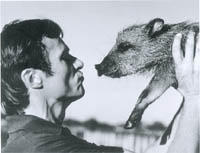
Pantanal swamps, Mato Grosso, Brazil (1978).
Dr. Schaller spent the late 1970s in Brazil in a study of jaguar,
alligators, capybara (a large rodent), and other species.
He likes wild pigs and here affectionately greets an infant white-lipped peccary
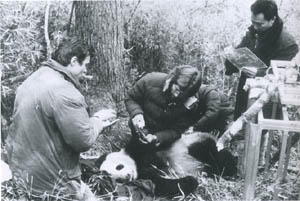
Wolong Natural Reserve, Sichuan (1981).
From 1980-1985, Dr. Schaller collaborated with Chinese scientists in the first detailed study of giant pandas.
Here he (on left) and his main coworker Hu Jinchu (on right) measure a sedated panda before radio-collaring it.
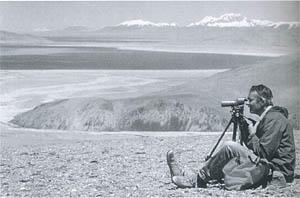
Northwest Tibet (1992). For the past ten years, Dr. Schaller has concentrated his research and conservation activities on the Chang Tang region of northern Tibet, a highland mostly above 4500m, to study Tibetan antelope, wild yak, and others. A reserve, 334,000 sq km in size, was established as a result of the joint effort by the Wildlife Conservation Society and Tibet's Forestry Department.
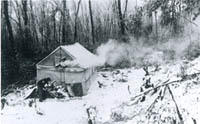 |
 |
| Wolong Reserve, Sichuan (1982). Dr. Schaller's research camp in panda country was simple. For two years, at all seasons, Dr. Schaller and his wife Kay lived in this tent. | The panda project conducted a training program for Chinese biologists and technicians. Here two coworkers locate a panda by radiotelementry and record its position by triangulation (1982). |
